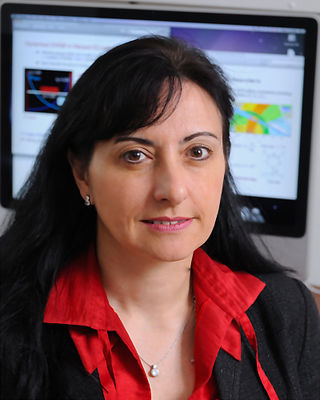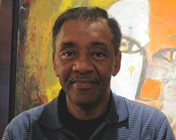Related Research Articles

The American Physical Society (APS) is a not-for-profit membership organization of professionals in physics and related disciplines, comprising nearly fifty divisions, sections, and other units. Its mission is the advancement and diffusion of knowledge of physics. The society publishes more than a dozen scientific journals, including the prestigious Physical Review and Physical Review Letters, and organizes more than twenty science meetings each year. APS is a member society of the American Institute of Physics. Since January 2021 the organization has been led by chief executive officer Jonathan Bagger.

Marcela Silvia Carena Lopez is an Argentine theoretical physicist, and distinguished scientist at the Fermi National Accelerator Laboratory in Batavia, Illinois, where she is also head of the lab's Theory Division. She is also a professor at the University of Chicago, where she is a member of the Enrico Fermi Institute and the Kavli Institute for Cosmological Physics.
The National Society of Black Physicists (NSBP), established in the United States in 1977, is a non-profit professional organization with the goal to promote the professional well-being of African Diaspora physicists and physics students within the international scientific community and the world community at large.

Anthony Michael Johnson is an American experimental physicist, a professor of physics, and a professor of computer science and electrical engineering at the University of Maryland, Baltimore County (UMBC). He is the director of the Center for Advanced Studies in Photonics Research (CASPR), also situated on campus at UMBC. Since his election to the 2002 term as president of the Optical Society, formerly the Optical Society of America, Johnson has the distinction of being the first and only African-American president to date. Johnson's research interests include the ultrafast photophysics and nonlinear optical properties of bulk, nanostructured, and quantum well semiconductor structures, ultrashort pulse propagation in fibers and high-speed lightwave systems. His research has helped to better understand processes that occur in ultrafast time frames of 1 quadrillionth of a second. Ultrashort pulses of light have been used to address technical and logistical challenges in medicine, telecommunications, homeland security, and have many other applications that enhance contemporary life.
Elmer Samuel Imes was an internationally renowned American physicist who made important contributions in quantum, demonstrating for the first time that Quantum Theory could be applied to the rotational energy states of molecules, as well as the vibration and electronic levels, Imes' work provided an early verification of Quantum Theory, and his spectroscopy instrumentation inventions, which include one of the earliest applications of high resolution infrared spectroscopy led to development of the field of study of molecular structure through infrared spectroscopy; he was also the second African American to earn a Ph.D. in physics and the first in the 20th century. He was among the first known African-American scientists to make important contributions to modern physics, others' prior work unrecorded or uncredited. While working in industry, he gained four patents for instruments to be used for measuring magnetic and electric properties. As an academic, he developed and chaired the department of physics at Fisk University, serving from 1930 to 1941.
Kennedy J. Reed was an American theoretical atomic physicist in the Theory Group in the Physics & Advanced Technologies Directorate at Lawrence Livermore National Laboratory (LLNL) and a founder of the National Physical Science Consortium (NPSC), a group of about 30 universities that provides physics fellowships for women and minorities.

Milton Dean Slaughter is an American theoretical and phenomenological physicist and affiliate professor of physics at Florida International University. Slaughter was a visiting associate professor of physics in the Center for Theoretical Physics, University of Maryland, College Park while on sabbatical from Los Alamos National Laboratory (LANL) of the University of California from 1984 to 1985. He is also chair emeritus and university research professor of physics emeritus at the University of New Orleans (UNO). Prior to joining UNO as chair of the physics department: He was a postdoctoral fellow in the LANL Theoretical Division Elementary Particles and Field Theory Group (T-8); LANL Theoretical Division Detonation Theory and Applications Group (T-14) staff physicist; LANL Theoretical Division affirmative action representative and staff physicist; LANL assistant theoretical division leader for administration and staff physicist (T-DO); LANL Nuclear and Particle Physics Group staff physicist—Medium Energy Physics Division (MP-4); and LANL Historically Black Colleges and Universities (HBCU) project manager (laboratory-wide).

Ronald Elbert Mickens is an American physicist and mathematician who is the Fuller E. Callaway Professor of Physics at Clark Atlanta University. His research focuses on nonlinear dynamics and mathematical modeling, including modeling epidemiology. He also has an interest in the history of science and has written on the history of black scientists. He is a fellow of the American Physical Society and served as the historian of the National Society of Black Physicists. He has made significant contributions to the theory of nonlinear oscillations and numerical analysis.
Mary B. James is an American physicist and educator. She is the Dean for Institutional Diversity and the A. A. Knowlton Professor of Physics at Reed College. James specializes in particle physics and accelerators.

Herman Brenner White is an American physicist who works at Fermilab. He won the 2010 American Physical Society Edward A Bouchet Award.

Willie S. Rockward is a physics professor and has served as the chair of the department of physics and engineering physics at Morgan State University since August of 2018. His research interests include Micro/Nano Optics Lithography, Extreme Ultraviolet Interferometry, Metamaterials, Terahertz imaging, Nanostructure Characterization, and Crossed Phase Optics. From 2018 to 2020 he was the president of the National Society of Black Physicists.

Sekazi Kauze Mtingwa: is an American theoretical high-energy physicist. He is a co-recipient of the 2017 Robert R. Wilson Prize for Achievement in the Physics of Particle Accelerators. He is the first African-American to be awarded the prize. Mtingwa was elected a Fellow of the American Physical Society (APS) in 2008 for "his definitive treatment of Intrabeam scattering, his contributions to the wakefield acceleration, and his early recognition of the fixed target physics potential of the next generation electron-positron collider." He also co-founded the National Society of Black Physicists in 1977 and served in various other national and international initiatives.
James Edward Young is an American physicist who was the first black tenured faculty member in the Department of Physics at Massachusetts Institute of Technology. He was a founding member of the National Society of Black Physicists and a mentor for Shirley Ann Jackson.
Donald Anderson Edwards was an American physicist. Edwards was the founding chair of the physics department at North Carolina A&T State University, and spent his career teaching there and at other historically Black colleges and universities across the United States. His research was in the field of X-ray diffraction crystallography, and he was known for his 1931 determination of the complete crystal structure of potassium nitrate.
John McNeile Hunter was an American physicist and chemist, and the third African American person to receive a PhD in physics in the United States. He spent the entirety of his career as a professor of physics at the Virginia State College, a historically Black college in Petersburg, Virginia, where he also established and served as the first chair of the college's physics department. Virginia State College's physics program was one of the first at a historically Black college in the country. Hunter's research was focused on thermionics.
Clayton Wilson Bates, Jr., is an American physicist and electrical engineer. Bates developed an x-ray image intensifier tube for use in diagnostic radiology and was an early researcher in optical and electronic properties of nanophase metal-semiconductor composite systems. He also chartered Stanford University's Society of Black Scientists and Engineers (SBSE) in 1973.
Wendell Talbot Hill III is an American physicist and professor at the University of Maryland. His research career has largely focused on the intersection of laser physics and quantum science.
Harry Lee Morrison was an American theoretical physicist and the first African American physics faculty member at the University of California, Berkeley. His research focused on statistical mechanics within theoretical physics, and he was known for his demonstration in 1972 of the absence of long-range order in quantum systems in two dimensions, that was a result from the breaking of a continuous symmetry.
Earl David Shaw is an American physicist and professor, known for his work in laser science and developing laser technology. He is credited as the co-founder of the spin-flip Raman tunable laser.
References
- 1 2 Roberson, Stephen (December 12, 2020). "February 14, 2020". National Society of Black Physicists.
- ↑ Calos, Kimberly Ann. "My neighbor, Jim Davenport". The Progress-Index. Retrieved February 24, 2021.
- ↑ Poffenberger, Leah (August 31, 2017). "Continuing a 40-year connection". Fermilab News.
- ↑ Engram, Dianne (November 4, 1988). "Davenport Cited by White House as Outstanding Professor" (PDF). FermiNews. p. 4.
- ↑ Ronald E. Mickens collection on African-American physicists, Box 1, File 11. Niels Bohr Library & Archives, American Institute of Physics. AR 2012-1067.
- ↑ Mickens, Ronald, ed. (1993). "James C. Davenport 1938-". The African American Presence in Physics. Atlanta: Horton Lind Communication. p. 54.
- ↑ Roach, Ronald (September 13, 2001). "A focus on physics". Black Issues in Higher Education. 18 (15): 24–28 – via Diverse Issues in Higher Education.
- ↑ Davenport, James (1993). "The National Society of Black Physicists: Reflections on Its Beginning". In Mickens, Ronald (ed.). The African American Presence in Physics. Atlanta: Horton Lind Communication. pp. 6–12.
- ↑ Wilson, Robert. "Robert R. Wilson letter of recognition to James C. Davenport" (December 26, 1985) [Textual record]. Ronald E. Mickens collection on African-American physicists, Box: 1, File: 11. Niels Bohr Library & Archives, American Institute of Physics. AR 2012-1067.